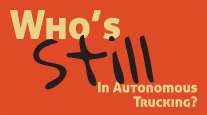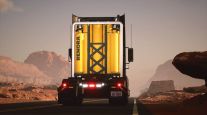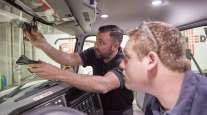Dimensioning Systems Add Efficiency to LTLs
By Susan L. Hodges, Contributing Writer
This story appears in the Aug. 11 print edition of Transport Topics.
Call it “automatic dimensioning,” “cubing” or “electronic measuring,” — all three are terms for technology that some believe could revolutionize less-than-truckload trucking.
“Our product is space,” said Lloyd Rawson, weighing and research manager for Saia LTL Freight in St. Johns Creek, Georgia. “There’s often a difference between a customer’s declared volume of a shipment and its actual size, particularly when a shipment is irregular in shape. We need to identify these discrepancies to invoice our customers, plan our resources and determine our costs correctly. Having access to accurate measurement data is critical to revenue recovery.”
Since early 2012, Saia LTL has installed 27 automatic pallet-dimensioning systems in company terminals throughout North America.
Automatic dimensioning products are designed to replace the manual use of a tape measure with digital technology that determines the length, width and height of individual packages, pallets or payloads. Generally, items to be “dimensioned” are placed on an electronic weighing platform, above which are mounted one or more imaging devices that “map” the item and measure it.
Rawson said results have met expectations. “Within one week, we were meeting our KBIs,” he said, referring to key business indicators. “We’re recovering revenue, we’ve reduced our operational ratio and we’ve improved the efficiency of our weighing and research inspectors.”
Depending on the system a carrier uses, dimensions are communicated after measuring to the carrier’s information system and used to plan loading. Dimensions produced by such a system or device also can be used to update carrier invoicing and generate additional revenue on packages inaccurately weighed or measured by shippers.
“You’ll have gains in at least two areas if you move to automated dimensioning,” said Michael Sutton, spokesman for Mettler-
Toledo International Inc., a global firm based in Columbus, Ohio, that manufactures a line of dimensioning systems used in LTL trucking. “You’ll have fewer hands touching each package, and because an automatic system moves faster, your throughput will also increase.”
Sutton said most dimensioning products are designed to capture an item’s weight, measurements and shape in a single process. “This can be done in a static environment, where an operator picks up an item and places it on the product platform to capture dimensions,” he said. “We also have a conveyor-belt unit with a bar code reader so that as a package moves by, we know what it weighs, what it looks like, its dimensions and its bar code. This multitasking eliminates error and increases efficiency.”
Several firms make dimensioning devices or systems, and each product works differently. Some are stationary installations that use lasers or three-dimensional cameras to measure packages or pallet loads and are scalable to the largest operations. Others use handheld devices such as smart phones and are designed for smaller operations. Still others mount to forklifts or truck-lifts and can be used for dimensioning loads already on a truck.
Shift Freight, an LTL carrier based in Santa Fe Springs, California, began using a dimensioning product called FreightSnap when the carrier opened its doors in mid-2013. “We had a choice between imaging none of the freight that hit our dock and using a dimensionalizer,” said Tommy Skinner, vice president of Shift Freight. “We thought dimensioning would provide value to our customers, and we were thorough in our testing of products available. We found that other companies have great dimensioning products but not the mobility of FreightSnap, and other products cost as much as $80,000 to $100,000 upfront.”
Mike Eichenberg, president of FreightSnap, in Mission, Kansas, said his firm’s dimensioning products use patented image technology that the company first developed for use in the home-improvement industry.
“We use basic trigonometry in software that does image analysis and measurement,” Eichenberg said. Because the software is built into a cloud application that users can access from nearly any device supporting an HTML5 browser, FreightSnap Mobile can be used on a smart phone or tablet. “With this product, you’re able to log in and snap a picture from any device,” said Eichenberg. “You’re using equipment you already own, so you don’t have the high cost of components.”
After a package or pallet is photographed, FreightSnap software catalogs the image and stores it on the Internet, in the cloud. Using the FreightSnap interface, carriers then can “dimension” the package on the spot and store the information or share it with designated individuals or departments in the company or across the firm’s supply chain.
Estes Express Lines, an LTL carrier based in Richmond, Virginia, uses a different product — FreightSnap 3D — for its offshore services to Alaska, Hawaii and Puerto Rico. Edward Alderman, vice president, said Estes chose the system for two reasons.
“Their advanced 3-D imaging technology provides the most accurate cube dimensions, regardless of freight type,” Alderman said. FreightSnap ”also offers both fixed and portable versions that are cloud-based. This allows us to provide more accuracy, flexibility and speed in terms of providing data to our customers.”
Alderman said Estes Express shippers also like “the added assurance of visual confirmation” of both dimensions and condition before the freight is loaded. “FreightSnap 3D has made it possible for [us] to leverage leading-edge cubing technology as a way to provide an improved customer experience for offshore shipping,” he said. “We’re pleased with the program and look forward to continued positive results.”
Unlike simpler FreightSnap products, FreightSnap 3D has components: one or more three-dimensional cameras, mounted at strategic locations on a loading dock. A 3-D camera is about the size of two boxes of business cards stacked together. Eichenberg said 10 cameras “can be used at one loading site and take up very little space.” A typical implementation of multiple 3-D cameras in a cross-dock situation would cost about $5,000, including software and a handheld device used to trigger the cameras, he said.
Dimensioning systems made by Integrated Visual Data Technology Inc., of Toronto, use still another approach. The company’s SkidWeigh Forklift onboard weighing and cubing system combines a fleet management system for lift trucks with onboard weighing and dimensioning capabilities. “There’s nothing else like it,” said spokesman Ted Jurca. “Our systems dimension cargo already on the truck at the point you need the correct information for billing.”
SkidWeigh systems operate on the electronic pressure transducer mounted on the hydraulic lift system of lift trucks. Jurca said the products can be installed by lift truck technicians. “These systems are automatic onboard check-weighing systems,” he said. “We make a similar product for forklifts.”
With so many products available and the variations among them, carriers debating the purchase of an automatic dimensioning product have their work cut out. Only one vendor would discuss price, but system size, package size, and the volume and complexity of a carrier’s loading operations also are considerations.
“Our systems have as much infrastructure as they do because of the lasers,” said Jerry Stoll, another spokesman for Mettler-Toledo. “We use three lasers to see 360 degrees around the freight and measure down to a ¼-inch in accuracy. If you compare the amount of hardware and technology we use to other systems and our level of accuracy, we have the highest rating for measuring irregularly shaped objects.”
For palletized systems measured with a floor scale, “We can use a conveyor system, but it takes up a lot of floor space, so [LTL carriers] usually don’t want it,” Stoll said.
When choosing a dimensioning product, he said, carriers should consider the percentage of irregularly shaped packages or loads they transport. “That’s key,” Stoll said, “because when you have items with oblong shapes or protrusions, it’s hard for equipment to map the full image. Watch out for dimensioning approvals that are for cubes only, because you could be leaving money on the table.”




